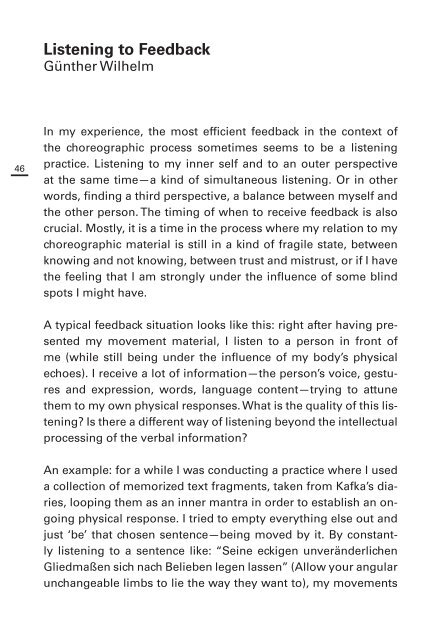Laboratory on Feedback in Artistic Processes 3
In its third edition the "Laboratory on Feedback in Artistic Processes" reflects on "Responses" within performing arts. The results of the previous Labs highlighted the need to take a closer look at the complexity and often subtle implications of feedback within the the artistic process itself. How do artist organise feedback and how do they process it? Who they want feedback from and what are its different roles? How can describe these relationships, and how does it shpae the artistic work? This booklet presents the different views on and experiences of feedback practices that were elaborated during the lab along the beforementioned questions and the insightfull contributions of its participants. Underpinning the following pages, three thematic fields have emerged: the impacts of feedback, feedback as a tool, and practicalities and contexts of feedback.
In its third edition the "Laboratory on Feedback in Artistic Processes" reflects on "Responses" within performing arts. The results of the previous Labs highlighted the need to take a closer look at the complexity and often subtle implications of feedback within the the artistic process itself. How do artist organise feedback and how do they process it? Who they want feedback from and what are its different roles? How can describe these relationships, and how does it shpae the artistic work?
This booklet presents the different views on and experiences of feedback practices that were elaborated during the lab along the beforementioned questions and the insightfull contributions of its participants. Underpinning the following pages, three thematic fields have emerged: the impacts of feedback, feedback as a tool, and practicalities and contexts of feedback.
Create successful ePaper yourself
Turn your PDF publications into a flip-book with our unique Google optimized e-Paper software.
Listen<strong>in</strong>g to <strong>Feedback</strong><br />
Günther Wilhelm<br />
46<br />
In my experience, the most efficient feedback <strong>in</strong> the c<strong>on</strong>text of<br />
the choreographic process sometimes seems to be a listen<strong>in</strong>g<br />
practice. Listen<strong>in</strong>g to my <strong>in</strong>ner self and to an outer perspective<br />
at the same time—a k<strong>in</strong>d of simultaneous listen<strong>in</strong>g. Or <strong>in</strong> other<br />
words, f<strong>in</strong>d<strong>in</strong>g a third perspective, a balance between myself and<br />
the other pers<strong>on</strong>. The tim<strong>in</strong>g of when to receive feedback is also<br />
crucial. Mostly, it is a time <strong>in</strong> the process where my relati<strong>on</strong> to my<br />
choreographic material is still <strong>in</strong> a k<strong>in</strong>d of fragile state, between<br />
know<strong>in</strong>g and not know<strong>in</strong>g, between trust and mistrust, or if I have<br />
the feel<strong>in</strong>g that I am str<strong>on</strong>gly under the <strong>in</strong>fluence of some bl<strong>in</strong>d<br />
spots I might have.<br />
A typical feedback situati<strong>on</strong> looks like this: right after hav<strong>in</strong>g presented<br />
my movement material, I listen to a pers<strong>on</strong> <strong>in</strong> fr<strong>on</strong>t of<br />
me (while still be<strong>in</strong>g under the <strong>in</strong>fluence of my body’s physical<br />
echoes). I receive a lot of <strong>in</strong>formati<strong>on</strong>—the pers<strong>on</strong>’s voice, gestures<br />
and expressi<strong>on</strong>, words, language c<strong>on</strong>tent—try<strong>in</strong>g to attune<br />
them to my own physical resp<strong>on</strong>ses. What is the quality of this listen<strong>in</strong>g?<br />
Is there a different way of listen<strong>in</strong>g bey<strong>on</strong>d the <strong>in</strong>tellectual<br />
process<strong>in</strong>g of the verbal <strong>in</strong>formati<strong>on</strong>?<br />
An example: for a while I was c<strong>on</strong>duct<strong>in</strong>g a practice where I used<br />
a collecti<strong>on</strong> of memorized text fragments, taken from Kafka’s diaries,<br />
loop<strong>in</strong>g them as an <strong>in</strong>ner mantra <strong>in</strong> order to establish an <strong>on</strong>go<strong>in</strong>g<br />
physical resp<strong>on</strong>se. I tried to empty everyth<strong>in</strong>g else out and<br />
just ‘be’ that chosen sentence—be<strong>in</strong>g moved by it. By c<strong>on</strong>stantly<br />
listen<strong>in</strong>g to a sentence like: “Se<strong>in</strong>e eckigen unveränderlichen<br />
Gliedmaßen sich nach Belieben legen lassen” (Allow your angular<br />
unchangeable limbs to lie the way they want to), my movements


















